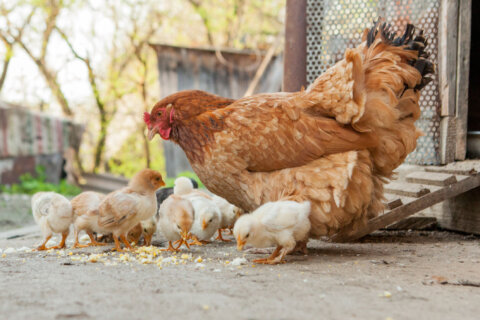WASHINGTON — Fairfax County Police say wildlife officials are getting more reports of coyotes.
Dr. Katherine Edwards, the county’s wildlife management specialist, said the foragers will not only eat trash, they could attack small animals — including pets.
Coyotes could see larger dogs as competitors since the mating season has just started, Edwards said in a news release.
Minimize your chances of encountering a coyote by keeping your pets inside, taking down bird feeders or outdoor pet bowls and securing your garbage can.
Never feed or attempt to “tame” a coyote, Fairfax County Police say. To keep them at bay, police suggest the following:
- Place garbage and compost in an animal-proof container, such as a metal trash can with latches on the lid or secure with bungee cords.
- Keep trash inside until the morning of trash pickup whenever possible.
- Do not feed pets outside or store pet food outside.
- Pick up ripe, fallen fruit and do not let it accumulate on the ground.
- Put away bird feeders at night to avoid attracting small rodents and other coyote prey.
- Trim shrubbery to ground level to remove hiding cover.
- Close up all openings under porches/decks, crawl spaces or outbuildings where animals might establish dens.
- Keep small pets inside and do not leave unattended when outside.
- Keep dogs on short leashes (less than 6 feet) while walking outside.
- Provide secure shelters for poultry, rabbits, and other vulnerable animals.
- Be alert at dusk and dawn. Coyotes are most active at night and early morning hours; however, they may be active during the day in search of food or denning sites.
If a coyote is in sight, Fairfax County police suggest using hazing techniques to frighten them:
- Yell and wave your arms at the coyote.
- Use noisemakers such as whistles, air horns, bells, “shaker” cans full of marbles or pennies, or pots and pans banged together.
- Throw nonedible objects in the direction of the coyote including sticks, small rocks, cans or tennis balls.
- Spray the coyote with a water hose, water guns or spray bottles with vinegar water, pepper spray or bear repellent.
- Install motion sensor lights or a motion-activated sprinkler around your home.
- Install fencing to keep coyotes out of yards. Fencing should be at least 6 feet tall, have an outward slanting overhang or roller-type device to prevent coyotes from climbing or jumping, and have an L-shaped mesh apron buried one to two feet to deter digging. Few fences are completely coyote-proof.








